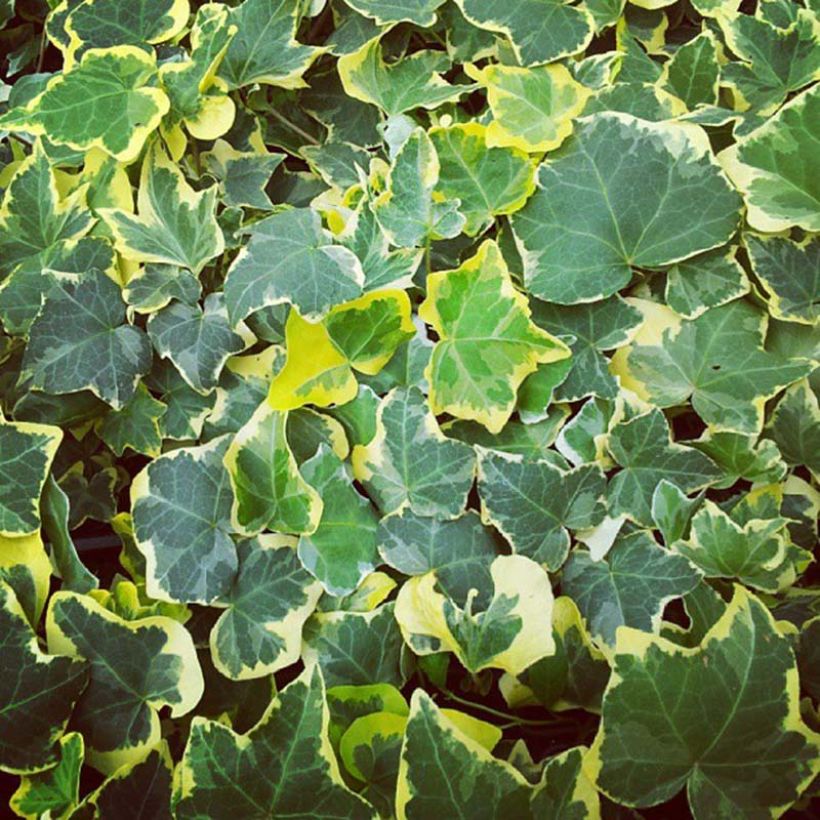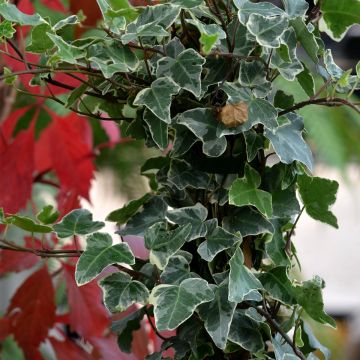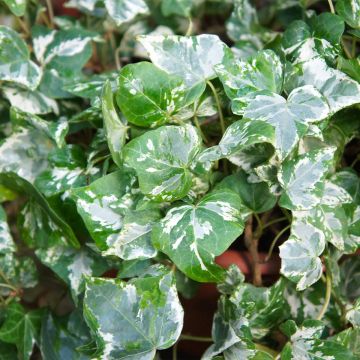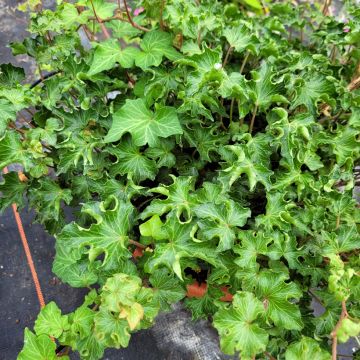

Hedera helix Goldchild - Common Ivy


Hedera helix Goldchild - Common Ivy
Hedera helix Goldchild - Common Ivy
Hedera helix Goldchild
English Ivy, Common Ivy, European Ivy
Disappointed upon receipt in a pot. Tiny and quite damaged plant. Let's hope it will thrive after being planted.
Linda, 20/05/2023
This item cannot be shipped to the selected country
Delivery charge from €5.90
Delivery charge from €5.90
More information
Schedule delivery date,
and select date in basket
This plant carries a 6 months recovery warranty
More information
We guarantee the quality of our plants for a full growing cycle, and will replace at our expense any plant that fails to recover under normal climatic and planting conditions.
From €5.90 for pickup delivery and €6.90 for home delivery
Express home delivery from €8.90.
From €5.90 for pickup delivery and €6.90 for home delivery
Express home delivery from €8.90.

Does this plant fit my garden?
Set up your Plantfit profile →
Description
The Hedera helix 'Goldchild' is a variety of common ivy with a modest size, highly ornamental throughout the year due to its beautifully variegated yellow foliage. Its small trilobed leaves have a light gray-green background, marbled with darker tones, and are widely bordered with yellow, which turns cream at maturity. It brings a lot of charm to partially shaded areas, in the garden of course, but also on the terrace or balcony. Bright and elegant, it can be used as both a small climbing plant and a ground cover, wherever shade prevails over sun.
Ivies belong to the araliaceae family, they are cousins of Ginseng and fatsias. The Hedera helix 'Goldchild' is a cultivar derived from common ivy, which can be found everywhere in our forests, countryside, and gardens. The latter is native to the entire temperate Eurasian zone of the northern hemisphere.
'Goldchild' is a moderately fast-growing climbing or creeping plant that can cover an area of 1.50 m². Its small evergreen leaves, triangular and divided into 3 lobes, are 4cm (2in) long, and are carried by thick, grayish branches with star-shaped hairs. Each leaf is different, but they all blend shades of gray-green, lighter or darker, and are regularly bordered with a light yellow band, which fades over time. The stems cling on their own to supports with powerful climbing roots. In autumn, the nectar from its inconspicuous green flowering, in the form of globular inflorescences, is an excellent source of nectar for bees. It is followed by the formation of black-blue berries, toxic to humans but representing an excellent winter food source for birds.
The hardy Hedera helix 'Goldchild' thrives everywhere except in hot or arid exposures. Its beautiful variegated foliage requires partial shade. This plant is a good non-invasive ground cover, but don't overuse it as it may eventually damage old walls or facades, especially when its branches are pulled away from their support. With ivy, action must be taken immediately or abstained from. On the other hand, variegated common ivies are irreplaceable for creating the setting of a terrace or balcony, trained on a small wire structure or trailing as draperies along large containers, down to the ground. In the garden, they form excellent ground covers capable of discouraging adventive plants in partial shade or even in shade. Pair them with easy-going woodland perennials such as epimediums, wood anemones, dead-nettles, or perennial geraniums like macrorrhizum or phaeum, for example.
Report an error about the product description
Hedera helix Goldchild - Common Ivy in pictures


Plant habit
Flowering
Foliage
Botanical data
Hedera
helix
Goldchild
Araliaceae
English Ivy, Common Ivy, European Ivy
Cultivar or hybrid
Other Hedera - Ivy
Planting and care
The Hedera helix 'Goldchild', which is easy to grow in any ordinary soil, can be planted all year round except during freezing or heatwave periods. It prefers a fertile soil that is moist but well-drained, but it is also quite adaptable (in terms of the presence of limestone or clay if the soil is well worked) and fairly resistant to drought once established. This variety is not the hardiest of all, but it can withstand short freezes of around -12/-14°C once established. It is best planted against a wall in a semi-shaded position sheltered from cold winds to help it establish, and monitor watering during the first 2 years after planting, especially during dry summers. To promote faster growth of young shoots, fix the first ones to the ground (layering). Don't hesitate to rejuvenate the base by removing old branches. Regular pruning is necessary to shape it. Remove any branches that have non-variegated leaves or those that take on an upright and bushy form, if applicable.
For container cultivation, mix 7 parts of ordinary soil, 3 parts of turf, and 2 parts of sand. Water regularly and apply fertilizer every month during the growing season. Keep the substrate moist during winter.
Planting period
Intended location
Care
-
, onOrder confirmed
Reply from on Promesse de fleurs
Foolproof climbers
Haven't found what you were looking for?
Hardiness is the lowest winter temperature a plant can endure without suffering serious damage or even dying. However, hardiness is affected by location (a sheltered area, such as a patio), protection (winter cover) and soil type (hardiness is improved by well-drained soil).

Photo Sharing Terms & Conditions
In order to encourage gardeners to interact and share their experiences, Promesse de fleurs offers various media enabling content to be uploaded onto its Site - in particular via the ‘Photo sharing’ module.
The User agrees to refrain from:
- Posting any content that is illegal, prejudicial, insulting, racist, inciteful to hatred, revisionist, contrary to public decency, that infringes on privacy or on the privacy rights of third parties, in particular the publicity rights of persons and goods, intellectual property rights, or the right to privacy.
- Submitting content on behalf of a third party;
- Impersonate the identity of a third party and/or publish any personal information about a third party;
In general, the User undertakes to refrain from any unethical behaviour.
All Content (in particular text, comments, files, images, photos, videos, creative works, etc.), which may be subject to property or intellectual property rights, image or other private rights, shall remain the property of the User, subject to the limited rights granted by the terms of the licence granted by Promesse de fleurs as stated below. Users are at liberty to publish or not to publish such Content on the Site, notably via the ‘Photo Sharing’ facility, and accept that this Content shall be made public and freely accessible, notably on the Internet.
Users further acknowledge, undertake to have ,and guarantee that they hold all necessary rights and permissions to publish such material on the Site, in particular with regard to the legislation in force pertaining to any privacy, property, intellectual property, image, or contractual rights, or rights of any other nature. By publishing such Content on the Site, Users acknowledge accepting full liability as publishers of the Content within the meaning of the law, and grant Promesse de fleurs, free of charge, an inclusive, worldwide licence for the said Content for the entire duration of its publication, including all reproduction, representation, up/downloading, displaying, performing, transmission, and storage rights.
Users also grant permission for their name to be linked to the Content and accept that this link may not always be made available.
By engaging in posting material, Users consent to their Content becoming automatically accessible on the Internet, in particular on other sites and/or blogs and/or web pages of the Promesse de fleurs site, including in particular social pages and the Promesse de fleurs catalogue.
Users may secure the removal of entrusted content free of charge by issuing a simple request via our contact form.
The flowering period indicated on our website applies to countries and regions located in USDA zone 8 (France, the United Kingdom, Ireland, the Netherlands, etc.)
It will vary according to where you live:
- In zones 9 to 10 (Italy, Spain, Greece, etc.), flowering will occur about 2 to 4 weeks earlier.
- In zones 6 to 7 (Germany, Poland, Slovenia, and lower mountainous regions), flowering will be delayed by 2 to 3 weeks.
- In zone 5 (Central Europe, Scandinavia), blooming will be delayed by 3 to 5 weeks.
In temperate climates, pruning of spring-flowering shrubs (forsythia, spireas, etc.) should be done just after flowering.
Pruning of summer-flowering shrubs (Indian Lilac, Perovskia, etc.) can be done in winter or spring.
In cold regions as well as with frost-sensitive plants, avoid pruning too early when severe frosts may still occur.
The planting period indicated on our website applies to countries and regions located in USDA zone 8 (France, United Kingdom, Ireland, Netherlands).
It will vary according to where you live:
- In Mediterranean zones (Marseille, Madrid, Milan, etc.), autumn and winter are the best planting periods.
- In continental zones (Strasbourg, Munich, Vienna, etc.), delay planting by 2 to 3 weeks in spring and bring it forward by 2 to 4 weeks in autumn.
- In mountainous regions (the Alps, Pyrenees, Carpathians, etc.), it is best to plant in late spring (May-June) or late summer (August-September).
The harvesting period indicated on our website applies to countries and regions in USDA zone 8 (France, England, Ireland, the Netherlands).
In colder areas (Scandinavia, Poland, Austria...) fruit and vegetable harvests are likely to be delayed by 3-4 weeks.
In warmer areas (Italy, Spain, Greece, etc.), harvesting will probably take place earlier, depending on weather conditions.
The sowing periods indicated on our website apply to countries and regions within USDA Zone 8 (France, UK, Ireland, Netherlands).
In colder areas (Scandinavia, Poland, Austria...), delay any outdoor sowing by 3-4 weeks, or sow under glass.
In warmer climes (Italy, Spain, Greece, etc.), bring outdoor sowing forward by a few weeks.























































